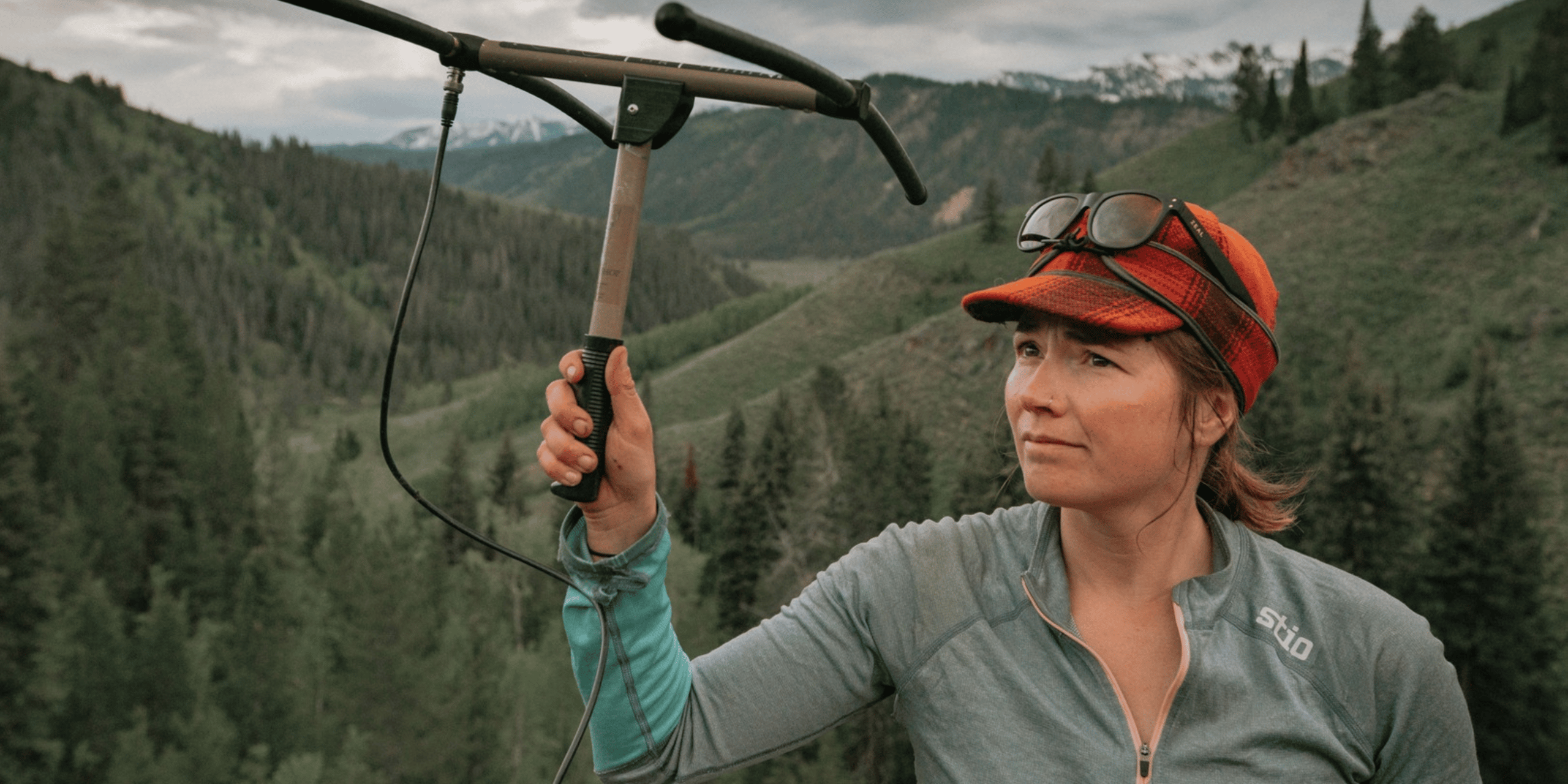Deer 132 interview
DCEFF recently caught up with Deer 139 co-director Morgan Heim and film subjects Anya Tyson, Sam Dwinnell, and Tennessee Watson for a quick Q&A
It’s clear this was a challenging journey at times for the subjects, how was the experience of tagging along in that challenging journey while trying to produce a documentary at the same time? What aspects of production were most complicated?
MH: As filmmakers, my co-director Jayme Dittmar and I had to make every step of the journey with the rest of the team. We had to carry camping gear and our camera equipment and still remain creative and vigilant during our most physical and non-physical parts of the expedition, often with not a lot of time to do multiple takes. We had to sometimes hike to other hillsides, or hang back or run ahead to get shots. And when the action slowed down, we’d have to stay focused because often that was when all these wonderful moments happened between the group. It was both one of the hardest and funnest things I’ve ever done.
What I can say is that the reason we were able to do it, and have the movie we have, is because we all worked together to share the load and keep the mood upbeat. Anya, Tennessee and Sam would take turns carrying some of our gear, and though Jayme and mine’s packs weighed about 70-lbs each, the rest of the team had packs clocking in closer to 100-lbs. We’d take things slow when we needed to, and would strategize on how to approach pivotal and more difficult events like river crossings, so that Jayme and I could make the most out of those more intense shooting moments.
I have to say, too, that Jayme and I had a knack for filling the gaps. It was like we were always managing to trade efforts. If one of us filmed less on a difficult climb, the other filmed more, and we did a good job of naturally balancing that. Probably the hardest things to manage had to do mostly with the housekeeping involved with taking care of equipment in all sorts of weather conditions: rationing batteries and memory cards, getting all of that backed up in the field and then staying in filmmaker mode when all you want to do is eat, relax and go to sleep. Actually, check that, the hardest thing was the tendency for the deer to show up right after you’d popped a squat to use the bathroom. Have you ever had to hold a squat for minutes? There, the deer would be milling about looking all beautiful and perfect. You both wouldn’t have your camera, couldn’t call to anyone and that’s when the deer would decide to hang out forever!
Why is it important for scientists and viewers to be able to experience these kinds of wildlife migrations first-hand?
AT: Before I went on this journey, I was already convinced that I valued mule deer and knew the importance of interconnected landscapes as a conservationist and former wildlife technician. Little did I know, my appreciation for migratory animals and their relationships to specific landscapes had whole dimensions to expand to as a result of this experience. For me, it is important that the audience go on the same journey; this film allows viewers to reassess whatever baseline relationship they had to deer and interconnected landscapes, whether they’re professional biologists or they mostly consider landscapes as backgrounds for their desktops. If a picture says a thousand words, a documentary film communicates that meaning tenfold. It’s critical for the public to make meaning of and make relationships with the more-than-human world, beyond just possessing a peripheral awareness of wildlife stats and figures. The process of walking 85 miles in Deer 139’s tracks generates deeper empathy and understanding for these animals. We need to get beyond our own perspective of a patch of sagebrush is a patch of sagebrush is a patch of sagebrush, and understand that, for a mule deer who lives or dies on her familiarity with specific seasonal ranges and routes, no one portion of a landscape is interchangeable for another.
TW: The Covid-19 pandemic offers an opportunity for humans to reflect on the importance of migration. The self-isolation in our homes has us hyper-aware of our own mobility and what it means to not have it. We don’t have an endless supply of everything we need at home. On a normal day, when we run out of something we hop on our bikes or jump in the car to go get more. Movement is essential to our survival just like it is for migratory animals. For mule deer the migration corridors that link their winter ranges and summer ranges allow them to eat all year. When there’s deep snowpack in the mountains they move to terrain with less snow and exposed forage. That’s their winter range. And when the snow melts up high all that water produces lush vegetation for good eating. That’s their summer range. Mule deer get by on the limited number of plants they eat on winter range, but they also need all those tasty greens from their summer range.
Let’s say you did a good job stocking up on food as the Coronavirus hit. Day one you made a delicious dinner with fresh ingredients full of nutrients and protein. But eventually, you run out of fruits and veggies, and all that’s left is plain spaghetti. You’re surviving but after days of only pasta, you’re feeling kind of low energy. That’s like eating on winter range. While restaurants are closed, public officials recognize that humans need to eat to survive so you can still go to the grocery store. You’re craving some variety, so you cautiously venture out to resupply on tasty nutritious food. That’s your summer range. This is hopefully a temporary situation for humans. We’ll use our collective power to overcome Covid-19 and there’ll be unrestricted access to restaurants and grocery stores once again.
That’s where the analogy between humans and mule deer ends. The mule deer population has been in decline over the last 50 years. Human development has encroached on mule deer migration corridors making the journey between their winter and summer ranges more dangerous and challenging. By following Deer 139, this film explores the challenges mule deer confront, and the power humans have to protect migration corridors and vital landscapes.
Tennessee, how did you come to meet Anya and Samantha? How did you end up agreeing to participate in this adventure? Any plans for similar adventures in the future?
TW: I met Sam in Laramie when our dogs stopped to smell each other’s butts. Then Sam and I kept seeing each other around town, and it wasn’t too long before we started going on long runs and adventures together. Sam invited me along on the Deer 139 adventure because of my background in journalism and documentary production. I work at Wyoming Public Radio and the station generously supported my participation in this project. I really didn’t get to know Anya until we all met up for the Deer 139 expedition. I’d go on another adventure with Sam and Anya any day. I can’t wait to see what Sam comes up with next.
What do you hope the DCEFF audience will take away from the film?
SD: The idea for this project first started out as a way of getting our science on mule deer ecology at the University of Wyoming beyond the walls of academia and into a form that is more palatable for a non-scientific audience. In particular, we wanted to reach audiences that value the outdoors but may not always be included in conversation surrounding wildlife issues, such as members of the outdoor recreation communities. Yet, as our team began to assemble and perspectives of other team members were presented, it quickly developed into something much more than an experiment in science communication to new audiences. This project became a way of sharing stories and philosophies around land ethic, conservation, and social responsibilities of caring for our cherished natural resources. The film itself developed into a lesson on the importance of reconnecting with our natural environments and developing an appreciation for the animals we often take for granted.
After all, I too did not always appreciate seemingly common species. I grew up in southern Minnesota where white-tailed deer seemed as common as corn fields, and when I moved to the Intermountain West in 2007, I regarded mule deer in a similar way—boring, common, uninspiring. I didn’t realize how incredible mule deer were until I studied a migratory population in Jackson, WY. One of my study animals migrated from winter range near downtown Jackson Hole to one of the high peaks of Grand Teton National Park, and there, she gave birth to her fawn in the last available patch of krummholz fir below the rocky summit. I admired her determination to call this challenging environment home.
This observation shifted my thinking around how I value wildlife species, and I realized that all animals do amazing things to survive. The fact of the matter is that it is hard to appreciate or connect with another creature if we don’t know anything about them. The context in which we associate wildlife determines our overall sentiment toward how we value them, but every organism has an impressive backstory. It only takes a willingness to see them in a new light to develop a rich appreciation for their existence. Now, when I see a mule deer, migratory or resident, I appreciate them for their resilience in living in such a challenging and ever-changing environment.
I hope this film has a similar effect on audiences. I hope it inspires people to look at an animal—whether it is a mule deer, magpie, or mountain lion—and contemplate what it means for that animal to be on the landscape, and the role we, as humans, play in their existence.


